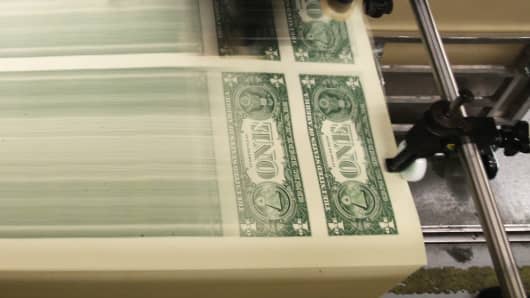The cost of a strong dollar: Billions in corporate damage

The market knew it would be ugly. Now, it’s become clear just how much havoc the strong dollar is wreaking on corporate America.
In the first three months of the year, companies in North America lost nearly $29 billion because of currency swings, according to FiREapps, a company that advises businesses on managing their currency exposure.
It’s not just the strong dollar, however. A pickup in currency volatility around the globe is costing corporations everywhere.
If you add losses European companies faced from currency swings, most notably the Russian ruble’s dramatic plunge, companies lost $31 billion in the quarter. The drag on North American and European profits was 57 percent greater than last quarter’s impact and four times as much as the same quarter a year ago.
No wonder companies from a diverse set of industries—including 3M,Pfizer, Ford and Facebook—have complained about it.
“As long as economies around the world remain weak and central banks there see intervention as a successful stimulus tool, then we should expect to see continued currency volatility,” according to FiREapps Q1 2015 Currency Impact Report.
Just last week South Korea and New Zealand surprised the markets by cutting interest rates to fight slow growth and low inflation.
For North American companies, the main culprit is the euro, with 142 of the 279 companies hit by such losses blaming the currency’s decline. The euro plunged 11 percent during the quarter, dragging down American company sales more than they did during the height of the European debt crisis.
“Here we are less than three years later and for most major U.S. dollar currency pairs, volatility has surpassed the height of the euro crisis – as have the negative impacts reported by U.S.-based multinationals,” according to FiREapps.
Other specific currencies cited by companies for inflicting pain include the Japanese yen, Russian ruble, Brazilian real and British pound.
“The variety of currency culprits reported by corporates in North America and Europe reflects the complexity of currency risk management for multinational corporations,” says FiREapps.
The darkest before the dawn?
When it comes to handling currency risk, companies have different and sometimes opaque strategies. Proctor and Gamble, which derives most of its sales outside the U.S, was among the hardest hit by what CEO A.G. Lafley called in its April earnings report “unprecedented currency devaluations.”
Lafley added: “As we have done before, we’ll offset foreign exchange over time through a combination of pricing, mix enhancement and cost reduction.”
PepsiCo gets little less than half of its sales abroad, including 7 percent from Russia, whose currency plummeted nearly 40 percent in the last year. The company doesn’t hedge its potential losses from overseas sales.
Instead, the beverage maker said it would “continue to take actions to manage through the current volatile macroeconomic environment by taking responsible pricing actions,” CEO Indra Nooyi said in the company’s first quarter earnings release. Such actions include tightly controlling costs, and optimizing our global sourcing to minimize and mitigate the impacts of the current foreign exchange challenges.”
Rival Coca-Cola, which has even greater international exposure than Pepsi, does hedge foreign sales in major markets like the euro and yen. It also took advantage of historically low interest rates in Europe during the first quarter by selling $9.5 billion worth of new bonds, in one of the biggest euro bond sales by an American company ever. That also helped offset the revenue exposure.
“The currency impact on income before taxes was less than our original expectations due to slightly more than a $0.01 benefit related to foreign currency re-measurement gains associated with the euro-denominated debt issuance,” according to the company.
No matter how effective those hedges and strategies to offset the losses may be, nearly all American companies with any foreign sales, are taking hits from foreign exchange.
There is, however, a silver lining to all the currency carnage: the worst of it may be behind us.
While analysts still predict heightened volatility in the months ahead, the current quarter could offer companies some relief. So far, the dollar has actually weakened in the second quarter, by nearly 5 percent against the euro—helping reverse some of the most intense strong dollar headwinds in corporate history.
[“source – cnbc.com”]
